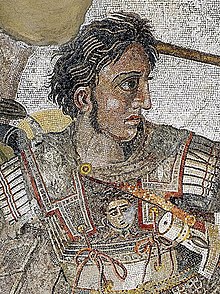Alejandro Magno
| Alexander the Great | |||||
|---|---|---|---|---|---|
| Basileus | |||||
 Alexander in theAlexander Mosaic | |||||
| King of Macedon | |||||
| Panahon kan Kapanyarihan | 336–323 BC | ||||
| Suminunod ki | Philip II | ||||
| Sinundan ni | |||||
| Hegemonof theHellenic League | |||||
| Panahon kan Kapanyarihan | 336–323 BC | ||||
| Suminunod ki | Philip II | ||||
| Sinundan ni | Demetrius I of Macedon | ||||
| Pharaoh of Egypt | |||||
| Panahon kan Kapanyarihan | 332–323 BC | ||||
| Suminunod ki | Darius III | ||||
| Sinundan ni |
| ||||
| King of Persia | |||||
| Panahon kan Kapanyarihan | 330–323 BC | ||||
| Suminunod ki | Darius III | ||||
| Sinundan ni |
| ||||
| Iminundag | 20 or 21 July 356 BC Pella,Macedon | ||||
| Nagadan | 10 or 11 June 323 BC (aged 32) Babylon,Mesopotamia,Macedonian Empire | ||||
| Spouse | |||||
| Isyu |
| ||||
| |||||
| Greek | ἈλέξανδροςPlantilya:Cref2 | ||||
| Dynasty | Argead | ||||
| Amá | Philip II of Macedon | ||||
| Iná | Olympias of Epirus | ||||
| Relihiyon | Ancient Greek religion | ||||
SiAlejandro III kan Macedonia(Ancient Greek:Ἀλέξανδρος,translit.Alexandros;20/21 Hulyo 356 BC – 10/11 Hunyo 323 BC), komun na midbid bilang siAlejandro Magno.[1]iyo an hade kansuanoy na Griyegongkahadean kanMacedoniaSinundan niya an saiyang ama na siFelipe IIsa trono kaidtong 336 BC sa edad na 20, asin ginugol an kadaklan kan saiyang taon sa pamayo sa pag-conduct nin halawig namilitary campaignsa bilog na Solnopan na Asya an saEhipto.Pag-abot niya sa edad na 30, tinogdas niya an saro sadakulaon na emperyosa kasaysayan, stretching poon saGresyapasiring sa amihanan-solnopan naIndya.[2]Dai pa siya nadadaog sa ralaban asin lakop na pigkokonsiderar na saro sa pinakamaurag asin matrayumpong komandante kan hukbo sa bilog na kasaysayan.[3][4]
Sagkod kan edad na 16, si Alexander tinokdoan niAristotle.Kaidtong 335 BC, pagkatapos kan saiyang pag-ako sa pagigin hade sa Macedon,nangampanya siya sa Balkanasin reasserted control saThraceasin mga parte kanIllyriabago nagmartsa sa syudad kanThebes,na kun saen andinistruir kan ralaban.Si Alexander dangan pinamayuhan anLiga kan Corinth,asin ginamit an saiyang otoridad na maglansar ninpan-Hellenic projectenvisaged kan saiyang ama, assuming liderato sa gabos naGriyegosa saindang conquest kanPersia.[5][6]
Toltolan
[baguhon|baguhon an source]- ↑Diana Spencer (2019)."Alexander the Great, reception of".Oxford Research Encyclopedia of Classics.Oxford Research Encyclopedias.doi:10.1093/acrefore/9780199381135.013.8048.ISBN978-0-19-938113-5.Archived fromthe originalon 10 November 2021.Retrieved9 November2021.
Alexander enjoys the epithet the Great for the first time in Plautus's Roman comedy Mostellaria (775–777).
Unknown parameter|url-status=ignored (help) - ↑Bloom, Jonathan M.; Blair, Sheila S. (2009)The Grove Encyclopedia of Islamic Art and Architecture: Mosul to Zirid, Volume 3.(Oxford University Press Incorporated, 2009), 385; "[Khojand, Tajikistan]; As the easternmost outpost of the empire of Alexander the Great, the city was renamed Alexandria Eschate (" furthest Alexandria ") in 329 BCE."Plantilya:PbGolden, Peter B.Central Asia in World History(Oxford University Press, 2011), 25; "[...] his campaigns in Central Asia brought Khwarazm, Sogdia and Bactria under Graeco-Macedonian rule. As elsewhere, Alexander founded or renamed a number of cities, such as Alexandria Eschate (" Outernmost Alexandria ", near modern Khojent in Tajikistan)."
- ↑Yenne 2010,p. 159.
- ↑"Alexander the Great's Achievements".Britannica.Archived fromthe originalon 2 July 2021.Retrieved19 August2021.Unknown parameter
|url-status=ignored (help)"Alexander the Great was one of the greatest military strategists and leaders in world history." - ↑Heckel & Tritle 2009,p. 99.
- ↑Burger, Michael (2008).The Shaping of Western Civilization: From Antiquity to the Enlightenment.University of Toronto Press. p. 76.ISBN978-1-55111-432-3.
